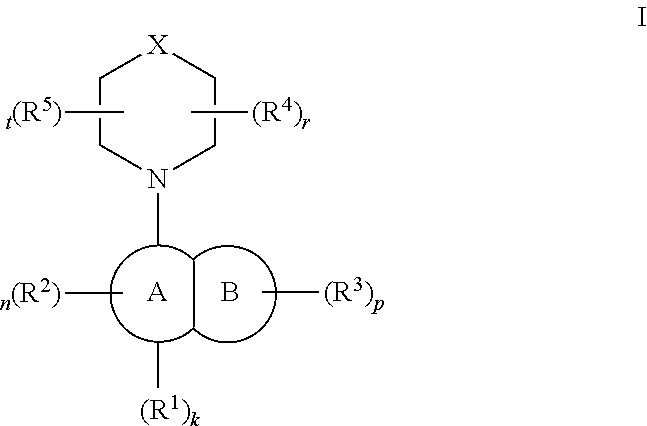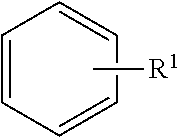Tlr7/8 antagonists and uses thereof
- Summary
- Abstract
- Description
- Claims
- Application Information
AI Technical Summary
Benefits of technology
Problems solved by technology
Method used
Image
Examples
example 1
of compound 1 (N-(2-(diethylamino)ethyl)-1-(1,8-naphthyridin-4-yl)piperidine-4-carboxamide)
[0274]
Method H
Ethyl 1-(1,8-naphthyridin-4-yl)piperidine-4-carboxylate
[0275]In a 25 mL reaction tube, ethyl piperidine-4-carboxylate (157 mg, 1.00 mmol) and DIEA (153 mg, 1.18 mmol) were added to a solution of 4-bromo-1,8-naphthyridine (190 mg, 0.91 mmol) in ethanol (10 mL) at room temperature. The tube was sealed and the reaction mixture was heated to 100° C. and stirred for 16 h. After cooling to room temperature, the reaction mixture was diluted with water (20 mL) and the resulting mixture was extracted with DCM (50 mL×3). The organic phases were combined, washed with brine and dried over Na2SO4. The solvent was removed under reduced pressure to yield 1-(1,8-naphthyridin-4-yl)piperidine-4-carboxylate as yellow solid (211 mg, 81%).
[0276](Note: In Method H, the solvent may also be acetonitrile, dmso or NMP instead of EtOH and the reaction temperature may range from 95° C. to 130° C.)
Method I
1-...
example 2
of compound 3 (1-(1-methyl-1H-pyrazolo[3,4-d]pyrimidin-4-yl)-N-(2-(piperidin-1-yl)ethyl)piperidine-4-carboxamide)
[0298]
Method K
1-(1-Methyl-1H-pyrazolo[3,4-d]pyrimidin-4-yl)-N-(2-(piperidin-1-yl)ethyl)piperidine-4-carboxamide
[0299]At 0° C., to a solution of N-[2-(piperidin-1-yl)ethyl]-1-[1H-pyrazolo[3,4-d]pyrimidin-4-yl]piperidine-4-carboxamide (67 mg, 0.19 mmol) in acetone (5 mL) was added MeI (53 mg, 0.37 mmol) and Cs2CO3 (100 mg, 0.31 mmol). The resulting solution was stirred for 1.5 h at 0° C. When the reaction was done, it was quenched by the addition of water (10 mL). The resulting mixture was extracted with DCM (30 mL×3) and the organic phases were combined, washed with brine and dried over Na2SO4. The solvent was removed under reduced pressure and the residue was purified by prep-HPLC under the following conditions: Column, XBridge C18 OBD Prep Column, 5 um, 19 mm×250 mm; Mobile phase, acetonitrile in water (with 10 mmol / L NH4HCO3), 10% to 23% gradient in 10 min; Detector, UV...
example 3
of compound 4 (N,N-diethyl-1-((1-(pyrido[2,3-b]pyrazin-8-yl)piperidin-4-yl)methyl)piperidin-4-amine)
[0301]
(1-(Pyrido[2,3-b]pyrazin-8-yl)piperidin-4-yl)methanol
[0302](1-(pyrido[2,3-b]pyrazin-8-yl)piperidin-4-yl)methanol was prepared from 8-chloropyrido[2,3-b]pyrazine and piperidin-4-ylmethanol using Method H. (1-[pyrido[2,3-b]pyrazin-8-yl]piperidin-4-yl)methanol was obtained as yellow solid (275 mg, 89%).
Method L
(1-(Pyrido[2,3-b]pyrazin-8-yl)piperidin-4-yl)methyl methanesulfonate
[0303]To a solution of (1-[pyrido[2,3-b]pyrazin-8-yl]piperidin-4-yl)methanol (250 mg, 1.02 mmol) and triethylamine (155 mg, 1.53 mmol) in dichloromethane (15 mL) was added methyl sulfonyl chloride (152 mg, 1.33 mmol) in several batches at room temperature. The resulting solution was stirred for 2 h at room temperature. When the reaction was done, it was quenched by the addition of water (20 mL). The resulting mixture was extracted with dichloromethane (40 mL×3), and the organic phases were combined, washed wi...
PUM
| Property | Measurement | Unit |
|---|---|---|
| Temperature | aaaaa | aaaaa |
| Temperature | aaaaa | aaaaa |
| Temperature | aaaaa | aaaaa |
Abstract
Description
Claims
Application Information
 Login to View More
Login to View More - R&D
- Intellectual Property
- Life Sciences
- Materials
- Tech Scout
- Unparalleled Data Quality
- Higher Quality Content
- 60% Fewer Hallucinations
Browse by: Latest US Patents, China's latest patents, Technical Efficacy Thesaurus, Application Domain, Technology Topic, Popular Technical Reports.
© 2025 PatSnap. All rights reserved.Legal|Privacy policy|Modern Slavery Act Transparency Statement|Sitemap|About US| Contact US: help@patsnap.com



